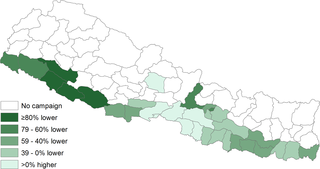PLOS Neglected Tropical Diseases ( IF 3.8 ) Pub Date : 2017-09-21 , DOI: 10.1371/journal.pntd.0005866 Shyam Raj Upreti 1 , Nicole P Lindsey 2 , Rajendra Bohara 3 , Ganga Ram Choudhary 3 , Sushil Shakya 3 , Mukunda Gautam 1 , Jagat Narain Giri 3 , Marc Fischer 2 , Susan L Hills 2

|
Background
Japanese encephalitis (JE) is a mosquito-borne disease that is associated with considerable morbidity and mortality in many Asian countries. The objective of this study was to describe the impact of the JE immunization program using SA 14-14-2 JE vaccine implemented in Nepal during 2006 through 2011. A previous assessment after the initial program implementation phase described a significantly lower post-campaign JE incidence compared to expected incidence; however, the previous evaluation had limited post-campaign data for some districts.
Methodology/Principal findings
JE and acute encephalitis syndrome (AES) data gathered through Nepal’s routine surveillance system from 2004 through 2014 were analyzed to assess the impact of the JE immunization program implemented in 31 districts. Expected incidence rates were determined by calculating the incidence of cases per 100,000 person-years in each district before the vaccination campaigns. This rate was applied to the relevant population after the vaccination campaigns, which provided the expected number of cases had the campaign not occurred. The observed incidence rate was the number of reported cases per 100,000 person-years post-campaign. Expected and observed JE and AES cases and incidence rates were compared. The post-campaign JE incidence rate of 0.7 cases per 100,000 was 78% (95% CI 76%–79%) lower than expected had no campaign occurred and an estimated 3,011 (95% CI 2,941–3,057) JE cases were prevented. The post-vaccination AES incidence of 5.5 cases per 100,000 was 59% (58%–60%) lower than the expected and an estimated 9,497 (95% CI 9,268–9,584) AES cases were prevented.
Conclusions/Significance
This analysis strengthens previous findings of the substantial impact of Nepal’s JE immunization program using SA 14-14-2 JE vaccine.
中文翻译:

对在尼泊尔实施减毒 SA 14-14-2 活疫苗的日本脑炎免疫计划影响的最新估计
背景
日本脑炎 (JE) 是一种蚊媒疾病,在许多亚洲国家与相当大的发病率和死亡率有关。本研究的目的是描述 2006 年至 2011 年期间在尼泊尔实施的使用 SA 14-14-2 乙脑疫苗的乙脑免疫计划的影响。在初始计划实施阶段之后的先前评估描述了运动后乙脑发病率显着降低与预期发病率相比;但是,之前的评估对某些地区的活动后数据有限。
方法论/主要发现
分析了从 2004 年到 2014 年通过尼泊尔常规监测系统收集的乙脑和急性脑炎综合征 (AES) 数据,以评估在 31 个地区实施的乙脑免疫计划的影响。预期发病率是通过计算疫苗接种活动前每个地区每 100,000 人年的病例发病率来确定的。该比率适用于疫苗接种运动后的相关人群,它提供了未发生该运动的预期病例数。观察到的发病率是运动后每 100,000 人年报告的病例数。比较了预期和观察到的 JE 和 AES 病例和发病率。活动后乙脑发病率为每 100,000 人 0.7 例,比未开展活动的预期低 78% (95% CI 76%–79%),估计为 3, 011 (95% CI 2,941–3,057) 乙脑病例得到预防。每 100,000 人中有 5.5 例的疫苗接种后 AES 发生率比预期低 59% (58%–60%),估计有 9,497 (95% CI 9,268–9,584) 例 AES 病例被预防。
结论/意义
该分析加强了先前关于尼泊尔使用 SA 14-14-2 乙脑疫苗接种乙脑免疫计划的重大影响的发现。



























 京公网安备 11010802027423号
京公网安备 11010802027423号